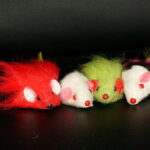Two of our daughters were born in July. Since we were poor as church mice when the first daughter grew up, the thought of presenting her with a piece of ruby jewelry never crossed our minds. When the younger daughter turned 18, we were in a somewhat better financial position, and since she was more interested in wearing jewelry than the first daughter had been, we decided to give her a ruby necklace. We mentioned the idea to her, and she seemed excited about it, so we began our search to find the perfect ruby for her.
Unfortunately, we had not looked into the price of rubies before setting out on this interesting expedition, and were disappointed to learn that they were much more expensive than we had imagined. However, we had committed ourselves, so we continued our search and finally came up with a ruby necklace that didn’t depress our finances too far beyond hope of recovery, and had it ready in time for her birthday.
The stone was small and delicate looking; a far cry from the huge red stone I had dreamed of giving her, but it was a ruby, and it was pretty. And, what mattered most was that she seemed pleased with her gift.
That experience got me interested in gemstones. I wondered why some were valued more than others; where they came from; how they were polished and cut to fit into different settings; and where some of the superstitions surrounding particular gemstones came from.
The ruby is ranked with the diamond, the emerald, and the sapphire as the top four precious stones, and comes in a variety of colors ranging from a pale pink to a deep, blood-red. Like diamonds, the clearer a ruby appears, the more valuable it is, but all natural rubies have some imperfections. Personally, I think the flaws make the stone much prettier.
Since so many rubies are flawed, most are subjected to treatment to improve their salability. Such treatments usually include some type of heat treatment. Exposing the stone to high heats usually makes the ruby a redder color, and thus likely to command a higher price.
Another popular treatment is that of filling fissures in the stone with lead or other fillers. This makes it more obvious that the stone has been treated, but may improve the attractiveness so the practice is common.
Most people are unaware that the first successful laser was developed by Theodore Maiman in 1960, based on his study of how the optical arrangement inside a ruby bounces back and forth when light hits the different colors. Synthetic rubies are now commonly used to make rods for use in laser instruments.(See link #1 below.)
The best rubies are mined in Myanmar, formerly known as Burma, but many well-known jewelers have stopped importing Myanmar rubies because of reports of human rights violations in the country. Unscrupulous mine operataors have been accused of drugging employees to increase their productivity, using shared needles making the likelihood of HIV infections breaking out among the workers. Laura Bush was actively involved in trying to stop large gem auctions that included stones from Myanmar. (See Link #2)
As with any costly gem, fake stones have become common, so if you are in the market for a high quality ruby, be sure you have it appraised by a reliable jeweler, before handing over any money.




